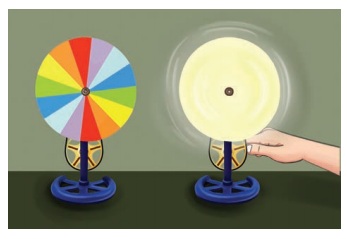Table of Contents
Activity 11.12- Creating a Newton’s Disc
Objective- To demonstrate how the seven colours of the spectrum, when mixed, can recreate white light. This activity uses a Newton’s disc to illustrate the concept.
Materials Needed-
- A circular disc or a thick paper plate.
- Colours (paints or markers) in red, orange, yellow, green, blue, indigo, and violet.
- A pencil or a small stick (to rotate the disc).
- A string or a motor (optional, for smoother rotation).
Procedure-

- Colour the Disc- Divide the disc into seven equal sections and colour each section with one of the seven spectrum colours (red, orange, yellow, green, blue, indigo, and violet).
- Attach to a Pivot- Make a small hole in the centre of the disc and insert a pencil or stick. This will be the pivot for rotation.
- Spin the Disc- Hold the pencil or stick between your palms and rub them together to spin the disc rapidly. You can also attach the disc to a motor for consistent spinning.
- Observe the Effect- As the disc spins faster, watch the colours blend visually, eventually appearing as white or light grey.
Also Check – Class 7 Science -Chapter 15 – Light- Complete Notes
Also Check – Chapter 11- A Detailed Guide to the Light Activities for Class 7 Students
Core Concepts Explained-
- Mixing of Colors- When the disc spins rapidly, our eyes can’t keep up with the changing colours. Instead, our brain blends these colours together.
- Formation of White Light- The rapid mixing of the seven colours of the spectrum (red, orange, yellow, green, blue, indigo, and violet) gives the illusion of white or light grey, demonstrating that white light is made up of these colours.
Possible Questions and Answers-
Why do the colours turn to white when the disc spins?
- Our eyes and brain perceive the fast-changing colours as a blend. Since the disc contains all the colours of light, this blend appears white, which is what white light is – a mixture of all colours.
Would it work if some colours were missing?
- For the best effect of seeing white, all seven colours should be present. Missing colours might result in a different blend, not pure white.
Why doesn’t it look white when the disc is not spinning?
- When the disc is stationary, our eyes can distinguish each individual colour. Only when it spins rapidly do the colours blend together visually.
Can this experiment show that sunlight is white?
- This experiment illustrates the principle that white light is a mix of all colours, similar to sunlight. However, it doesn’t directly prove that sunlight is white.
Is this how rainbows form?
- Rainbows are formed by the dispersion of sunlight through water droplets, which is the opposite process. The droplets split white sunlight into its constituent colours.